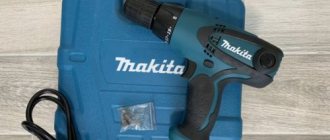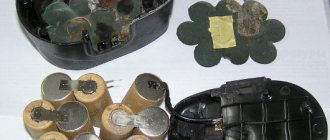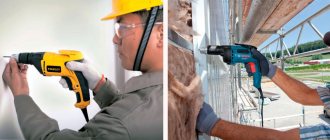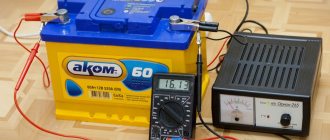Everyone knows how to charge a screwdriver - insert it into the charger and wait for the charging indicator to change color. But few people know that rechargeable batteries need to be maintained and properly discharged. Unfortunately, power tool manufacturers provide very little information in their instruction manuals. We will tell you how to properly charge and maintain a screwdriver battery in this article.
Charging rules
In order for the screwdriver to work properly throughout its service life, it is necessary to charge it in accordance with the following rules:
- Before initial use, the device must always be charged until the battery is fully charged. As a rule, even those models that are supplied with charged batteries need to be recharged - due to a decrease in battery capacity due to natural discharge during long-term storage.
- Models equipped with nickel-cadmium batteries require a 3-4-fold procedure - full charging and subsequent discharging. Only the 4-5th charge will give the required result, after which the device can be fully used. In this way, the full operating level of the battery capacity is restored.
- Instances with lithium-ion, more advanced batteries require only one full initial charge.
- If the screwdriver is idle for a long time, it is better to remove the 12-volt battery, or a set of batteries, from the device and disconnect it from the charger, but in order to prevent damage and maintain functionality, it is necessary to charge it prophylactically for 20-30 minutes once a month.
Before storage, the battery must be removed from the screwdriver Source ixbt.com
- The loading procedure must take place in optimal environmental conditions - at a temperature of 10-400C and normal humidity.
- During charging, the device body must not be allowed to overheat above 500C.
- Nickel-cadmium batteries can be stored for a long time without recharging - after idle time they can be reanimated with 3-4 full charge-discharge cycles.
- Lithium-ion batteries should not be completely discharged during storage. The minimum discharge level is 50%.
Advice! The service life and operating time of the battery depend not only on compliance with charging and operating rules, but also on quality. Therefore, it is better to purchase the device from reliable sales points and well-known manufacturers.
Recommendations for storing batteries
In order for the battery to last a long time, it must be stored correctly:
- Do not leave the battery in the tool.
- The place must be dry. Dampness negatively affects battery components.
- Sudden changes in temperature should be avoided.
These were general requirements, details are in the table.
| Battery | Storage Features |
| Ni-Cd | Plant to the level at which the screwdriver operates at half capacity. |
| Ni-MH | Must be fully charged. |
| Lithium | Needs to be discharged by half. |
Types of batteries
No matter how long a screwdriver has been around, it is never used under the same conditions - in one case the battery is enough for all the work, in another it needs to be constantly charged. Therefore, all modern models are divided according to the original battery capacity, and therefore according to cost - into household and professional.
Screwdriver with double set of batteries for professional work Source onlinetrade.ru
Screwdrivers are equipped with 3 types of batteries:
- Nickel-cadmium. The most common type of battery. They are characterized by small size, high capacity and reasonable cost. The number of charging cycles under good operating conditions can exceed 1000. The main disadvantages are the memory effect, which reduces capacity, and the harmfulness of production, which is why many manufacturers no longer produce it.
- Nickel metal hydride. The latest generation of batteries. They are characterized by a smaller memory effect and harmless production, but require constant charge support, otherwise a complete recharge will be required. In addition, they have a high self-discharge current.
- Lithium-ion. Batteries that completely eliminate memory effect. They feature fast charging and maximum capacity. However, they are also not without drawbacks - they are not suitable for working at low temperatures and are quite expensive.
Important! Do not allow lithium-ion batteries to be completely discharged, as this will disable the protection system. As a result, the device will overheat when charging and may simply burn out.
Screwdriver equipped with a lithium-ion battery Source my-shop.ru
See also: https://m-strana.ru/services/otdelochnye-materialy/
Charging time
The question of how long it takes to charge a screwdriver battery is far from idle. Since this parameter is sometimes decisive when choosing a particular model for a specific application. For example, there are situations when the user cannot afford to wait many hours for the battery to be fully charged before continuing installation work.
The battery charging time depends not only on its capacity, but also on the characteristics of the charger. The latter are divided into two types:
- Standard. For use on household power tools. Restoring capacity requires a long period of time - from 3 to 7 hours.
- Pulse. Used for professional screwdrivers. With their help, charging time is significantly reduced - on average no more than 1 hour.
Recommendation! To charge the battery, you must use only branded chargers or their analogues with the same supply voltage parameters. Otherwise, you can simply burn the battery - with all the ensuing consequences.
Charging a screwdriver battery with a standard charger Source ixbt.com
Disassembling the housing part of the autonomous power supply
When you are convinced that several deep charge/discharge cycles of the battery have not given a positive result, and your battery still discharges quickly during operation, follow the step-by-step action scenario. For example, let's take the battery for a Makita .
- Before proceeding with the actual disassembly process, charge the device.
- To gain access to the capacitive elements of the battery, you need to unscrew several fixing screws.
- Sometimes it is necessary to carefully break open the housing at the junction of structural parts.
Attention: when implementing the last dismantling option, do not use excessive physical force, as this will deform the plastic housing of the battery. Remember: after “restoration” work, the container must fit securely into place.
Common problems and their solutions
Often, when operating a screwdriver with a battery, a number of characteristic problems arise:
- The battery is not charging.
- There is no proprietary memory.
- Need to charge or discharge before long term storage.
Let's look at them in more detail.
Not charging
If the battery of a screwdriver simply does not charge, the reason may lie in a breakdown of the charger, a malfunction of the device, or the exhaustion of the battery itself. The problem is solved in the following ways:
- Replacing the battery with a new one.
- Returning the contact terminals in the device to their normal state - if they have become bent after long-term use, they should be bent back.
- Cleaning metal contacts that are dirty or oxidized after prolonged use.
- By pumping the nickel-cadmium battery through successive 3-5 charge-discharge cycles.
Advice! Continuous operation of the screwdriver will be ensured by a double set of batteries. When one fails, you can install a second one in the device and continue working, while the first one can be recharged.
Disassembling a screwdriver to check the electrical circuit and clean the contacts Source pochini.guru
No charger
In cases where it becomes necessary to charge the screwdriver battery without a proprietary charger, you can use the following methods:
- Use any other suitable charging device with similar supply voltage characteristics. A match must be required in terms of capacitance, voltage and polarity. In this case, the power can be any - only the charging time will depend on this indicator. However, it is better to select it so that the battery is charged in a standard time - as with a proprietary charger, for example, 5-7 hours.
- Connect the car charger with optimal parameters, observing polarity and monitoring the heating temperature of the battery case.
- Connect a universal charger with setting the required current parameters.
What to do if there is no charge
If the battery is not charged, there may be the following reasons:
- Charger fault.
- Lack of contact between the battery and the charger.
- Protection sensor faulty.
- Residual capacity is very small.
- Malfunction of individual battery cells.
The serviceability of the charger can be checked with a voltmeter or another battery.
Batteries and chargers have 3 pins or more. Additional contacts provide connection to the protection sensor(s) located in the battery. For nickel elements this is a thermal switch. If the battery reaches a temperature above +40... +50°, the thermal switch turns off the charger. The thermal switch must be in the closed state. If it is open all the time, this is a sign of a malfunction. You can short-circuit the “T” contact to the negative of the battery and charge without overheating protection. But it will be necessary to monitor the temperature of the battery and turn it off if the temperature is above +40°. Lithium ones can have an entire integrated circuit with many protection elements. They control not only the temperature of the elements, but also the degree of charge of each.
The malfunction of an individual element is detected by the voltage of the charged battery. Even a battery that has no capacity must be charged to its rated voltage. If the rated voltage matches, then all the elements have some kind of capacity and produce a voltage close to the rated one. Carry out training cycles: if the capacity increases, the battery can be restored. Continue training cycles until charge and discharge times stop increasing.
When the voltage of a charged battery is less than a multiple of the voltage of 1 cell, there is a high probability of failure of the individual batteries from which it is assembled. The battery is disassembled and each element is tested. The faulty ones are removed and the good ones are soldered in their place. From two faulty batteries, you can assemble one of the remaining serviceable elements.
Briefly about the main thing
To properly charge the screwdriver battery, a number of requirements must be met:
- Fully charge before first use.
- Nickel-cadmium batteries are recharged 3-4 times.
- Lithium-ion batteries are recharged in one cycle.
- During long-term storage, batteries must be removed from the device.
- The procedure must take place under optimal external conditions.
- It is unacceptable to heat the block above 500C.
- Nickel-cadmium batteries can be stored discharged.
- Lithium-ion batteries cannot be stored when they are more than half discharged.
In addition to lithium-ion and nickel-cadmium batteries, there are nickel-metal hydride batteries. Each variety has its own characteristics. The time to charge a screwdriver depends on the battery capacity and the type of charger - usually varies from 1 hour to 7 hours. During operation of the device, a number of problems may arise - the battery has stopped charging, there is no native charger and how to properly store the device, with a charged or discharged battery.
Ratings 0











